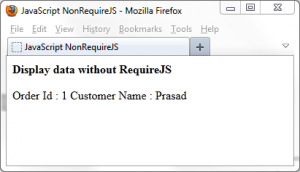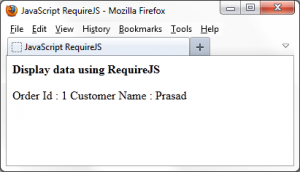
Whether it is simple or complex, web applications are composed of some HTML, JavaScript, and CSS files. Usually developers will use third-party JavaScript frameworks such as JQuery, Knockout, Underscore, etc. to improve development speed. Since these JavaScript frameworks have been developed for specific purposes and have been "proven", it is more appropriate to use them directly than to implement the required functions from scratch. However, as the complexity of applications continues to increase, it becomes increasingly important to write clean, low-coupling, and maintainable code. In this article, I will explain how the RequireJS framework helps application developers write more modular code and how it improves application performance by lazily loading JavaScript files.
We will start without the RequireJS framework, and then refactor it using RequireJS in the next chapter.
The following HTML page contains a
element with the id "message". When the user visits this page, it will display the order ID and customer name information.
The Common.JS file contains the definitions of two modules - Order and Customer. The function showData is combined with the body of the page. It puts the information to be output into the page by calling the write function. As an example, I hardcoded the Id to be 1 and the customer name to be Prasad in the showData function.
<!DOCTYPE html> <html> <head> <title>JavaScript NonRequireJS</title> <script src="common.js" type="text/javascript"></script> </head> <body> <strong>Display data without RequireJS</strong> <p id="message" /> <script type="text/javascript"> showData(); </script> </body> </html> Common.JS
function write(message) {
document.getElementById('message').innerHTML += message + '</br>';
}
function showData() {
var o = new Order(1, "Prasad");
write("Order Id : " + o.id + " Customer Name : " + o.customer.name);
}
function Customer(name) {
this.name = name;
return this;
}
function Order(id, customerName) {
this.id = id;
this.customer = new Customer(customerName);
return this;
}
 Although the above code is able to display the output, it still has some problems:
Although the above code is able to display the output, it still has some problems:
The Common.JS file contains all the functions that need to be defined (write, showData), and the modules (Order, Customer) are difficult to maintain and reuse. If you want to reuse the write function in other pages and reference the above JavaScript file, then you have also imported other functions and modules that may not be needed for this page.
Now let’s look at the refactored code. The HTML code below references the Require.JS file. The data-main attribute defines the only entry point for this page. In the scenario below, it tells RequireJS to load Main.js on startup.
<!DOCTYPE html> <html> <head> <title>JavaScript RequireJS</title> <script src="Require.Js" type="text/javascript" data-main="Main.js"></script> </head> <body> <strong>Display data using RequireJS</strong> <p id="message" /> </body> </html>
Since this file has been specified via the data-main attribute, RequireJS will load it as quickly as possible. This file uses functions of the RequireJS framework to determine and define dependencies on other JavaScript files. In the code snippet below, the first parameter represents the dependency (depending on the Order.JS file), and the second parameter is a callback function. RequireJS analyzes all dependencies and loads them, then executes this callback function. Please note that the value of the first parameter (Order) must be consistent with the file name (Order.JS).
require(["Order"], function (Order) {
var o = new Order(1, "Prasad");
write(o.id + o.customer.name);
});
The RequireJS framework provides an easy way to define and maintain dependencies between JavaScript files. The define function in the code below declares that Customer.JS must be loaded before processing the Order callback function.
define(["Customer"],
function (Customer) {
function Order(id, custName) {
this.id = id;
this.customer = new Customer(custName);
}
return Order;
}
);
This file does not depend on any other JavaScript files, so the value of the first parameter of the define function is an empty array.
Okay, now open this application with your browser, you will see the following output. Note that RequireJS only loads required JavaScript files.

Summary
In this article, we analyze how the RequireJS framework handles dependencies between JavaScript files and loads them as needed. It helps developers write code that is more loosely coupled, modular, and maintainable.
Thank you
Download source code: Lazy Loading using RequireJS (Prasad Honrao, Codetails)




